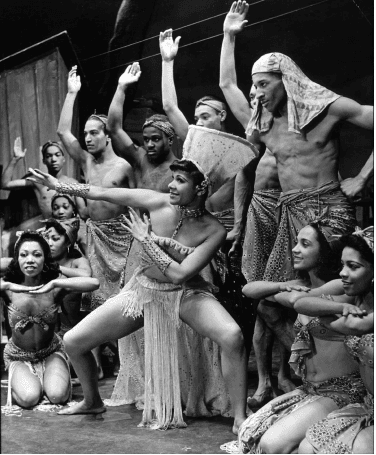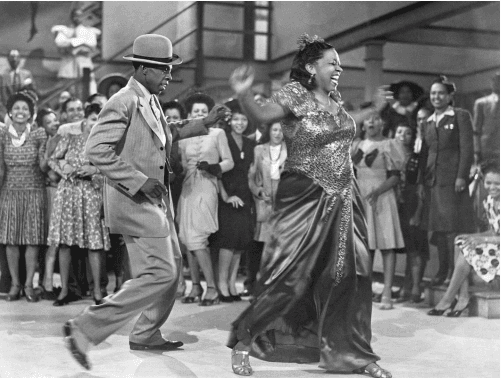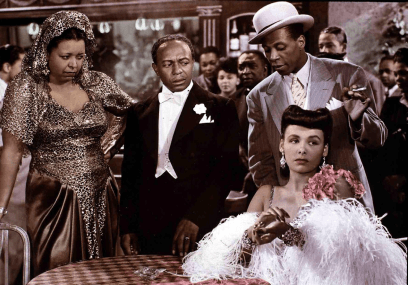Symphony in Black: Black Performance in Music, Theater, and Film
Maya Hall
8 min read
Listen to this study note
Study Guide Overview
This study guide covers the Harlem Renaissance and Jazz Age, focusing on key figures like Langston Hughes and the rise of the Apollo Theater. It explores the origins and evolution of blues and jazz music, highlighting the Great Migration's influence and various jazz subgenres. The guide also examines African American contributions to theater and film, including the significance of Cabin in the Sky and the careers of performers like Ethel Waters, Josephine Baker, and Paul Robeson. Finally, it provides practice questions and exam tips for the AP African American Studies exam.
#AP African American Studies: Music, Theater, and Film Review 🎶🎬
Hey! Let's get you totally prepped for the AP exam. We're going to break down African American contributions to music, theater, and film, making sure you're confident and ready to ace it! This guide is designed to be your best friend tonight, so let's dive in!
#1. The Foundations: Harlem Renaissance & Jazz Age 💡
The Harlem Renaissance and Jazz Age were pivotal for African American arts, creating new platforms and celebrating Black identity. Think of it as a cultural explosion! 💥
-
Harlem Renaissance (Early 1900s):
- A flourishing of African American cultural and intellectual life in Harlem, NYC.
- Writers like Langston Hughes and Zora Neale Hurston celebrated Black identity and experience.
- The Apollo Theater became a key venue for Black performers.
-
Jazz Age (Early 1900s):
- Record labels began signing more African American musicians.
- Radio helped spread genres like blues, gospel, and jazz nationwide.
Remember Harlem Renaissance with Hughes and Harlem, and Jazz Age with Jazz and Radio.
#2. Blues Music: Origins and Evolution 🎶
Blues music is a powerful expression of African American experience, evolving from hardship to resilience.
-
Origins:
- Emerged during slavery in the American South.
- Early blues was acoustic folk music with a single singer and guitar or harmonica.
- Lyrics reflected both hardship and resilience.
-
Evolution:
- The Great Migration transformed blues as African Americans moved to northern cities.
- Electric blues emerged in cities like Chicago and Detroit, with amplified instruments and full bands.
- Urban blues reflected the challenges of industrial city life.
-
Characteristics:
- Emotive vocals, repetitive lyrics, call-and-response patterns.
- Use of African American Vernacular English.
- Themes of despair, hope, love, loss, and overcoming adversity.
- Often follows a 12-bar chord progression and features improvisation.
Think of the Great Migration Going North, transforming Blues from Acoustic to Electric!
#3. Jazz as an American Art Form 🎷
Jazz is considered America's most significant homegrown art form, blending African and European traditions.
-
Origins:
- Originated in African American communities of New Orleans in the early 1900s.
- Blends African and European musical traditions.
- Emphasizes improvisation, syncopation, and complex harmonies.
-
Evolution:
- Spread and evolved as African Americans migrated from the South.
- Diverse subgenres emerged:
- Big band swing (1930s-40s)
- Bebop (1940s-50s)
- Cool jazz, hard bop, modal jazz, free jazz (1950s-70s)
- Continues to evolve, absorbing influences from other genres and cultures.
- Contemporary jazz artists experiment with fusions of jazz, hip hop, electronic, and world music.
Remember New Orleans as the birthplace of Jazz, and it's all about Improvisation and Syncopation.
- Jump back to Harlem Renaissance & Jazz Age
- Jump back to Blues Music
- Jump to Black Performers in Entertainment
#4. African American Theater and Film 🎭🎬
#Black Performers in Entertainment
Black performers broke barriers in entertainment, from cabarets to Broadway and Hollywood, challenging stereotypes.
-
Early 20th Century:
- Black performers found success in cabarets, featuring singers, dancers, and comedians.
- Broadway musicals like Shuffle Along (1921) launched stars like Josephine Baker and Paul Robeson.
- Black actors began appearing in mainstream Hollywood films, though often in stereotypical roles.
-
All-Black Cast Musicals:
- Major Hollywood studios produced all-Black cast musicals.
- Cabin in the Sky (1943) starred Ethel Waters, Lena Horne, Louis Armstrong, and Duke Ellington's orchestra.
- Stormy Weather (1943) featured Fats Waller, Cab Calloway, and the Nicholas Brothers.
-
Ethel Waters:
- First African American to headline her own TV show in 1939, a landmark achievement.
- Nominated for an Academy Award in 1949 for Pinky.
Think of Black Performers Breaking Barriers on Broadway and in Hollywood.
#5. Required Sources
#Duke Ellington - 'It Don't Mean a Thing' (1943) (video, 2:45)
This piece exemplifies jazz innovation, blending improvisation and sophisticated orchestration. It served as a form of cultural resistance during segregation.
#Katherine Dunham, Cabin in the Sky, 1940

Dunham's choreography fused African and Caribbean dance with ballet and modern dance, elevating Black dance on Broadway.
#Ethel Waters in Cabin in the Sky, 1943

Waters' role in Cabin in the Sky was a breakthrough for African American performers in Hollywood, challenging stereotypes and showcasing Black talent.
#Cast of Cabin in the Sky, 1943

This film was a significant milestone in African American cinema, featuring an all-Black cast in a major Hollywood production, though it also reflected the era's racial limitations.
#6. Final Exam Focus 🎯
These are the topics that often come up on the AP exam:
-
Key Topics:
- The Harlem Renaissance and its impact on African American arts.
- The origins and evolution of blues and jazz music.
- The role of African American performers in breaking barriers in theater and film.
- The cultural significance of works like Cabin in the Sky and Duke Ellington's music.
-
Common Question Types:
- Multiple-choice questions testing factual knowledge and analytical skills.
- Short-answer questions requiring concise explanations.
- Free-response questions (FRQs) that ask you to synthesize information and make arguments.
-
Last-Minute Tips:
- Time Management: Quickly scan questions and allocate time accordingly. Don't get stuck on one question.
- Common Pitfalls: Avoid overgeneralizations, be specific in your answers, and always support your claims with evidence.
- FRQ Strategy:
- Understand the prompt, plan your response, and write clearly.
- Use specific examples and connect them to the broader themes.
- Make sure to address all parts of the prompt.
Focus on understanding the why behind the events, not just the what. Connect the dots between different units to show a comprehensive understanding.
#7. Practice Questions
Practice Question
Multiple Choice Questions
-
Which of the following best describes the impact of the Harlem Renaissance on African American culture? (A) It led to the decline of traditional African art forms. (B) It created new platforms for Black artists and celebrated Black identity. (C) It primarily focused on political activism and social reform. (D) It had minimal impact on the development of jazz music.
-
What is a key characteristic of blues music? (A) Complex harmonies and syncopated rhythms. (B) Primarily instrumental with no vocals. (C) Emotive vocals, repetitive lyrics, and call-and-response patterns. (D) Focus on lighthearted and joyful themes.
-
Which of the following is considered a significant contribution of Katherine Dunham? (A) Developing the bebop style of jazz music. (B) Creating all-Black cast musicals in Hollywood. (C) Fusing African and Caribbean dance forms with ballet and modern dance. (D) Pioneering the use of electric instruments in blues music.
Short Answer Question
Briefly explain how the Great Migration influenced the evolution of blues music. (3 points)
Free Response Question
Analyze the significance of the 1943 film Cabin in the Sky in the context of African American representation in Hollywood. In your response, consider the film's historical context, its impact on Black performers, and its reflection of racial dynamics in the United States during the World War II era. (6 points)
Scoring Breakdown for FRQ
- Historical Context (2 points):
- 1 point for identifying the historical period (World War II era).
- 1 point for explaining the limited opportunities for Black actors in Hollywood at the time.
- Impact on Black Performers (2 points):
- 1 point for discussing how the film provided rare leading roles for Black actors.
- 1 point for explaining how it showcased the depth of talent in the Black entertainment community.
- Reflection of Racial Dynamics (2 points):
- 1 point for explaining how the film challenged racial stereotypes.
- 1 point for discussing how it also reflected the era's racial attitudes and limitations.
Alright, you've got this! Take a deep breath, review this guide, and go rock that AP exam! You're ready! 💪
Continue your learning journey

How are we doing?
Give us your feedback and let us know how we can improve





